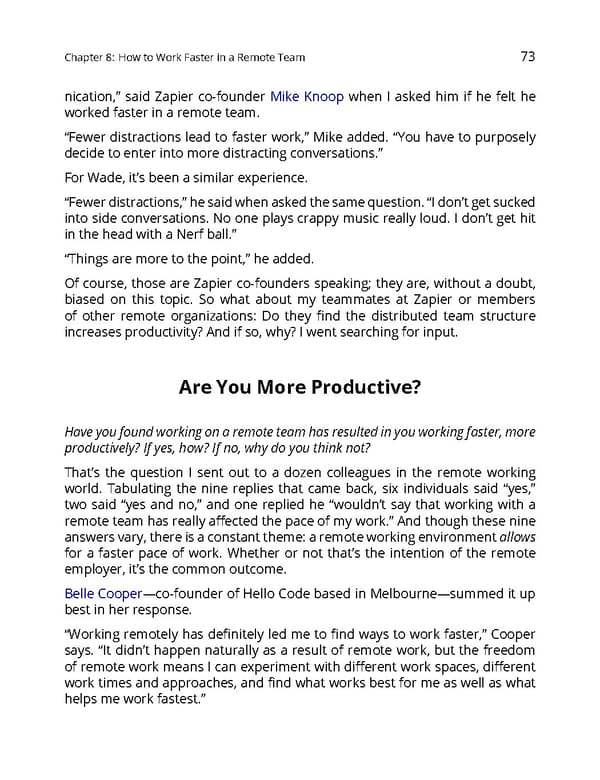Chapter8: HowtoWorkFasterinaRemoteTeam 73 nication,” said Zapier co-founder Mike Knoop when I asked him if he felt he workedfasterinaremoteteam. “Fewer distractions lead to faster work,” Mike added. “You have to purposely decide to enter into more distracting conversations.” For Wade,it’s been a similar experience. “Fewerdistractions,”hesaidwhenaskedthesamequestion.“Idon’tgetsucked into side conversations. No one plays crappy music really loud. I don’t get hit in the head with a Nerf ball.” “Things are more to the point,” he added. Of course, those are Zapier co-founders speaking; they are, without a doubt, biased on this topic. So what about my teammates at Zapier or members of other remote organizations: Do they find the distributed team structure increases productivity? And if so, why? I went searching for input. AreYouMoreProductive? Haveyoufoundworkingonaremoteteamhasresultedinyouworkingfaster,more productively? If yes, how? If no, why do you think not? That’s the question I sent out to a dozen colleagues in the remote working world. Tabulating the nine replies that came back, six individuals said “yes,” two said “yes and no,” and one replied he “wouldn’t say that working with a remoteteamhasreallyaffectedthepaceofmywork.”Andthoughthesenine answersvary,thereisaconstanttheme:aremoteworkingenvironmentallows for a faster pace of work. Whether or not that’s the intention of the remote employer,it’s the common outcome. Belle Cooper—co-founder of Hello Code based in Melbourne—summed it up best in her response. “Working remotely has definitely led me to find ways to work faster,” Cooper says. “It didn’t happen naturally as a result of remote work, but the freedom of remote work means I can experiment with different work spaces, different worktimesandapproaches,andfindwhatworksbestformeaswellaswhat helps meworkfastest.”
 The Ultimate Guide to Remote Work Page 76 Page 78
The Ultimate Guide to Remote Work Page 76 Page 78